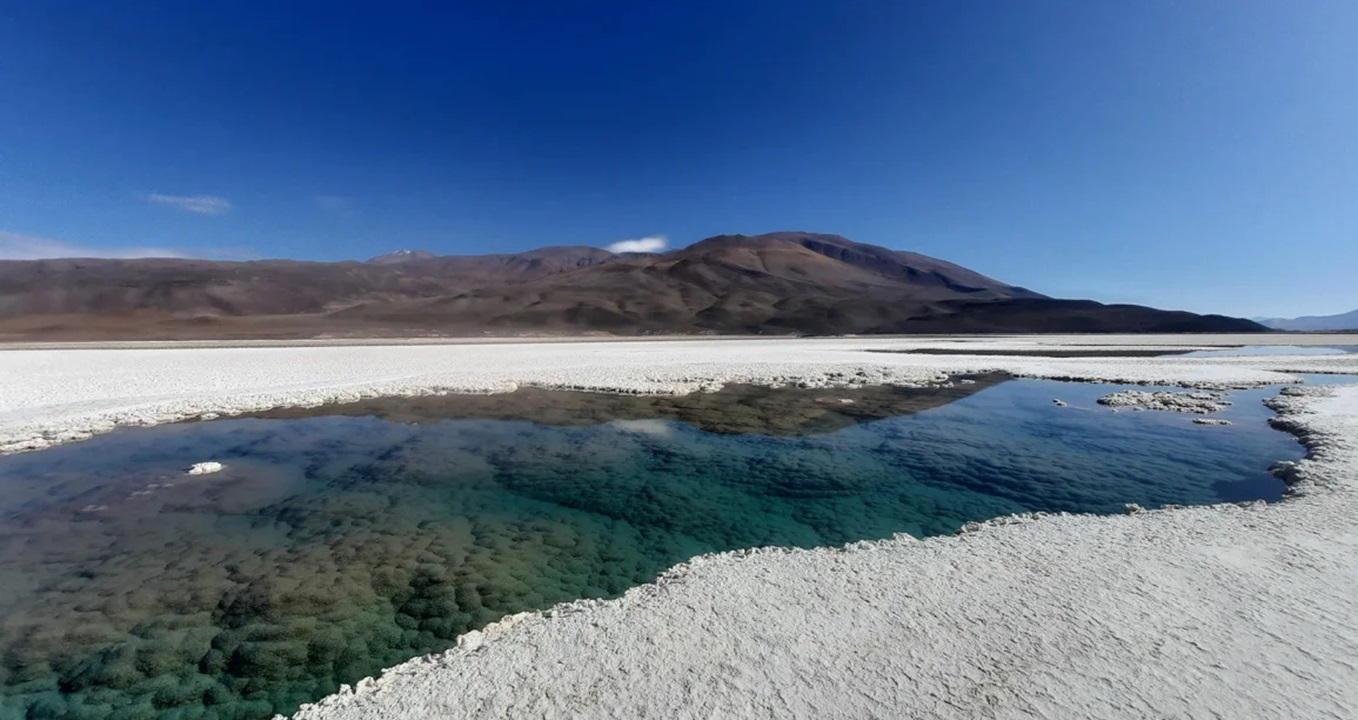(CNN) — Scientists have discovered a previously hidden ecosystem with a vast system of lakes in the salt plains of Puna de Atacama, an arid plateau in Argentina, with giant stromatolites that could offer a glimpse of the first life on Earth and perhaps even on Mars, according to a new research study.
Stromatolites are layered rocks created by the growth of blue-green algae, or cyanobacteria, through photosynthesis. The structures are considered one of the oldest ecosystems on Earth, according to a potIt represents the oldest fossil evidence of life on our planet since < /span> at least. 3.5 billion years ago
“They certainly resemble some of the oldest macrofossils on our planet, and in a really rare type of environment on modern Earth,” said Brian Hynek, a professor in the Department of Geological Sciences at the University of Colorado Boulder, who helped discover the creatures. Ecosystem documentation. “It’s a window into the distant past of what life was like 3.5 billion years ago on our planet.”
Ancient giant stromatolites were widespread in Earth’s Precambrian era, which in the early period extended from about 4.6 billion to 541 million years ago, but are now sparsely distributed around the world. The best developed areas are in the Bahamas and the Shark Bay region of Western Australia, according to the non-profit Nature Conservancy. Bush Heritage Australia.
Hynek said modern stromatolites are relatively small, while ancient stromatolites typically grow up to 20 feet (6 meters) long and 16 to 22 feet (5 to 7 meters) wide. Beneath the waters of the Atacama Puna Lakes, the newly discovered stromatolites are up to 15 feet (4.5 meters) wide and several feet high, according to a press release from the University of Colorado Boulder.
The newly discovered giant stromatolites at Puna de Atacama consist mainly of gypsum and saltpeter minerals. Brian Hynek
Stromatolites also tend to grow in alkaline conditions, but the lake system at Puna de Atacama is acidic. Hynek said that the stromatolites found today are almost all carbonate rocks (made of limestone), but these structures are mainly composed of the minerals gypsum and halite (rock salt). It is unclear why the stromatolites are so large, but he speculates. Their internal ecosystem remained intact for a long period of time, allowing them to grow unhindered.
More about ancient stromatolites
Unlike modern stromatolites, ancient stromatolites grew during a period when the atmosphere lacked oxygen. Under these conditions, stromatolite microbes used anoxygenic photosynthesis, which does not require oxygen, to convert light energy into compounds that support living cells.
“It is amazing to find structures that could be biological in origin (produced by living organisms) at this unusual altitude,” said Peter Fisher, professor of marine sciences. at the University of Connecticut, who has studied stromatolites extensively, in an email. “The main problem with this discovery, whether biological or not, is that these form in the presence of oxygen (in the current atmosphere). Even 2.3 billion years ago there was no oxygen.
While stromatolites are found in an oxygen-containing environment, Hynek said he believes the deeper layers in the rock have little or no access to oxygen and are actively formed by microbes through anoxygenic photosynthesis. This would make the structures similar to those found on ancient Earth.
Argentina’s lake system was initially discovered through satellite images in April 2022. Brian Hynek
Hynek discovered the lake system through satellite images in April 2022 when studying another lake in northwestern Argentina that contains smaller stromatolites with microbes that use anoxygenic photosynthesis.
“We’re not sure if microbes are actively involved in their growth (in the newly discovered stromatolites). We think they are,” said Hynek, who documented the initial observations with microbiologist Maria Farias, co-founder of environmental consultancy Punabio SA. “We’re still experimenting to try to figure that part out.” “There’s a lot of work to be done. “We just discovered them and have barely scratched the surface.”
Hynek and Farias were scheduled to present their findings on December 11 at the 2023 meeting of the American Geophysical Union in San Francisco, according to a press release.
A potential window into ancient Mars
If stromatolites are produced by microbes through anoxygenic photosynthesis, the discovery could provide insight into the possibility of life on ancient Mars, Hynek said.
We have identified more than 600 ancient lakes on Mars; Maybe there was an ocean. “So from the beginning it was very much like Earth.” Hynek also said that the minerals gypsum and halite, found in stromatolites in Argentina, are also found in salt deposits throughout Mars.
This artist’s animated concept depicts a scene of flowing water on the edge of Mars. Jezero Crater, which is now being explored by NASA’s Perseverance rover.
“If life on Mars evolved through photosynthesis, that’s the kind of thing we’d be looking for (stromatolites) and that’s the kind of thing we’d be looking for,” said Hynek, who is also a research associate at the Mars Laboratory. Atmospheric and space physics at the University of Colorado at Boulder.
“If we wanted to find any kind of fossils on Mars, this is our best guess as to what they would be, because they are the oldest in the terrestrial rock record.”
Hynek said he hopes to return to the lake soon to conduct more research on stromatolites.
“Stromatolites on Mars? A long shot, but who knows. So far there are no carbonates on Mars, but the search continues,” looking for possible signs of life, Fisher said.

“Proud web fanatic. Subtly charming twitter geek. Reader. Internet trailblazer. Music buff.”

:quality(85)/cloudfront-us-east-1.images.arcpublishing.com/infobae/TEQF6EONZRFGLLLDIDD4L2O4EE.jpg)

:quality(75)/cloudfront-us-east-1.images.arcpublishing.com/elcomercio/XU32LRAEZFDDPNVHLFU3CKVBYY.jpg)



More Stories
How to create 3D videos with my iPhone, it will be very useful even for your business
NASA discovers an anomaly in the Earth’s magnetic field that could have serious consequences for humans
Can the Earth be divided into two parts?